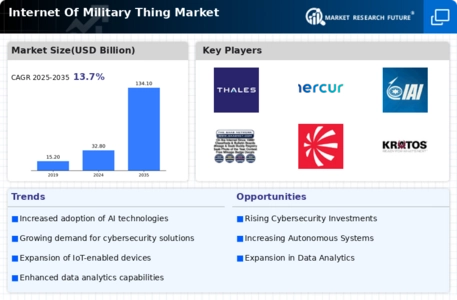Increased Defense Budgets
The Internet Of Military Thing Market is experiencing a notable surge due to increased defense budgets across various nations. Governments are allocating substantial financial resources to modernize their military capabilities, which includes investing in advanced technologies such as IoT. For instance, defense budgets in several countries have seen an uptick of approximately 5 to 10 percent annually, reflecting a commitment to enhancing national security. This financial commitment is likely to drive the adoption of IoT solutions, as military organizations seek to leverage real-time data and connectivity to improve operational efficiency. The integration of IoT technologies into defense systems is expected to facilitate better decision-making processes, thereby enhancing overall military effectiveness.
Emphasis on Autonomous Systems
The Internet Of Military Thing Market is witnessing a shift towards autonomous systems, which are increasingly being integrated into military operations. The development of unmanned aerial vehicles (UAVs) and autonomous ground vehicles is reshaping the landscape of modern warfare. These systems rely heavily on IoT technologies to communicate and operate effectively. The market for autonomous military systems is projected to expand significantly, with estimates suggesting a growth rate of around 20 percent over the next few years. This emphasis on autonomy not only enhances operational efficiency but also reduces the risk to human personnel. As militaries around the world continue to explore the potential of autonomous systems, the Internet Of Military Thing Market is likely to benefit from this trend.
Rising Demand for Real-Time Data
The Internet Of Military Thing Market is significantly influenced by the rising demand for real-time data in military operations. As military strategies evolve, the need for immediate access to information has become paramount. This demand is driving the adoption of IoT devices that can collect, analyze, and transmit data instantaneously. Reports indicate that the market for military IoT solutions is projected to grow at a compound annual growth rate of around 15 percent over the next five years. This growth is indicative of the military's recognition of the value of data-driven decision-making. By utilizing IoT technologies, armed forces can enhance situational awareness, streamline logistics, and improve mission outcomes, thereby reinforcing the importance of real-time data in modern warfare.
Growing Focus on Network Security
The Internet Of Military Thing Market is increasingly characterized by a growing focus on network security. As military operations become more reliant on interconnected systems, the potential vulnerabilities associated with cyber threats have come to the forefront. Governments and military organizations are investing in robust cybersecurity measures to protect sensitive data and maintain operational integrity. The market for military cybersecurity solutions is anticipated to grow at a rate of approximately 10 percent annually, reflecting the urgent need for secure communication channels. This focus on network security is crucial for the successful implementation of IoT technologies in military applications, as it ensures that the benefits of enhanced connectivity do not come at the cost of security.
Advancements in Sensor Technologies
The Internet Of Military Thing Market is being propelled by advancements in sensor technologies, which are integral to the functionality of IoT systems. Modern sensors are becoming increasingly sophisticated, enabling the collection of diverse data types, from environmental conditions to troop movements. The proliferation of miniaturized sensors has made it feasible to deploy them in various military applications, enhancing surveillance and reconnaissance capabilities. The market for military sensors is expected to witness a growth rate of approximately 12 percent annually, driven by the need for enhanced operational capabilities. These advancements not only improve the effectiveness of military operations but also contribute to the overall growth of the Internet Of Military Thing Market, as they form the backbone of IoT solutions.

















Leave a Comment